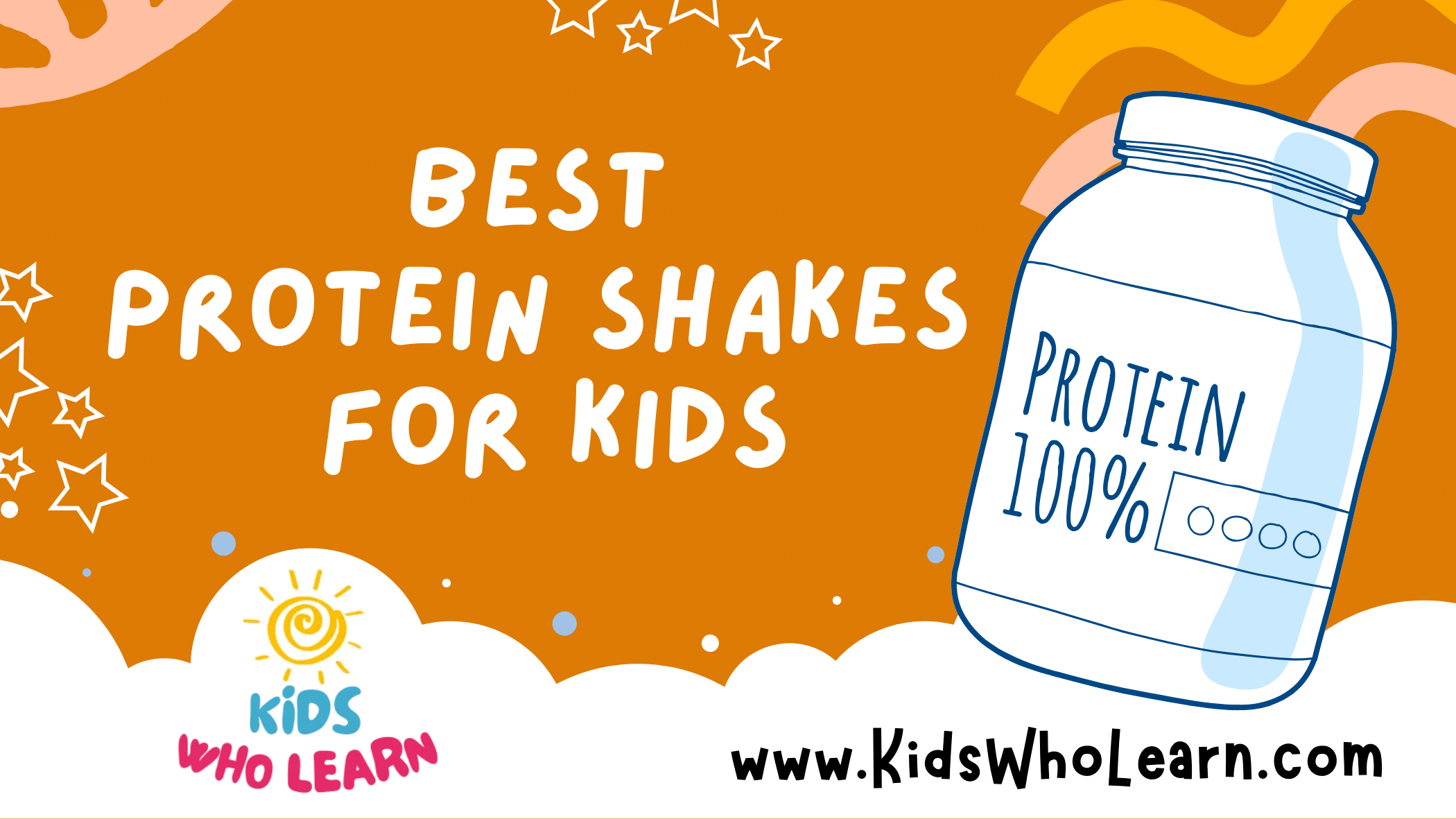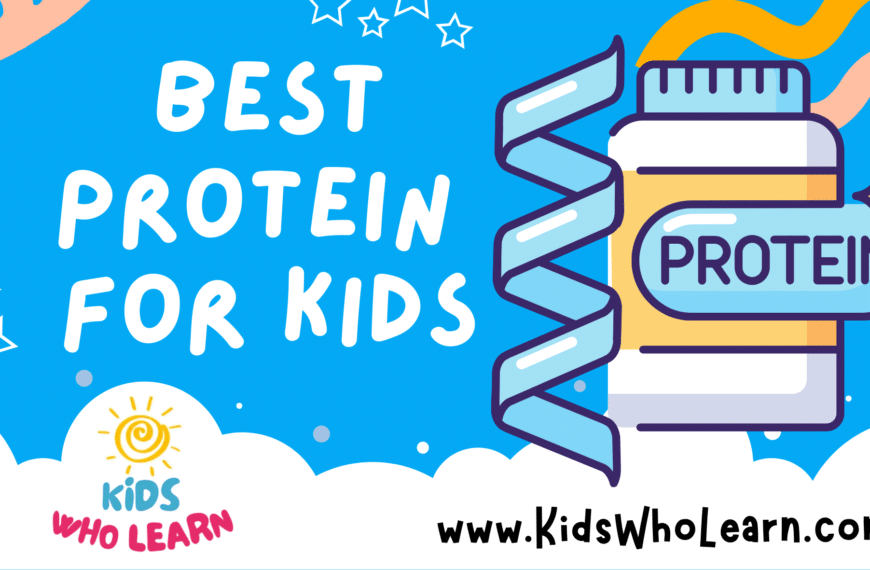Protein shakes for kids have become a popular topic as parents and caregivers strive to ensure their children receive sufficient nutrients for healthy growth and development. While whole foods should always be the cornerstone of a child’s diet, protein shakes can serve as a convenient supplement for kids who need additional protein or have increased nutritional requirements. It’s vital, however, to approach this dietary addition with care to ensure that the shakes are safe, healthy, and appropriate for a child’s diet.
Proper protein intake is crucial for children as it supports various bodily functions including muscle growth, tissue repair, and enzyme and hormone production. Given the importance of protein, parents must understand what constitutes a suitable protein shake for their child. This includes knowing which ingredients will provide protein as well as additional nutrients and what to look for in ready-to-drink options or powders. With an array of products on the market, it’s essential to select ones that align with a child’s dietary needs and to avoid those with excessive sugars or artificial additives.
Children with active lifestyles, especially those engaged in sports or physical activities, might require more protein than their less active peers. However, the key is to optimize their overall diet to incorporate protein naturally through meals and snacks, using protein shakes as a complementary addition rather than a primary source. Consultation with health professionals can provide guidance tailored to an individual child’s needs, ensuring their diet supports their growth without relying excessively on supplements.
Key Takeaways
- Protein shakes can be a convenient supplemental source of nutrients for children when used appropriately.
- Choosing the right protein shake involves looking for healthy ingredients and avoiding those with excessive sugars or additives.
- It’s important to balance a child’s overall diet and consult with health professionals for personalized dietary advice.
Understanding Protein and Its Importance for Kids
Protein is crucial for your child’s growth and health, serving as a building block for strong muscles and bones. Meeting daily protein requirements is essential to support your child’s development and overall well-being.
The Role of Protein in Growth and Development
Protein is an essential nutrient that plays a vital role in the growth and development of kids. It is necessary for building, maintaining, and repairing tissues in the body. Proteins are made up of smaller units called amino acids, some of which are produced by the body, while others must be obtained through diet, these are known as essential amino acids.
For children, protein is particularly important as it contributes to the growth of muscles and bones. It also supports the body in biochemical reactions by contributing to the formation of enzymes that facilitate these processes. Protein is necessary for your child’s energy levels and is indispensable for the development of a robust immune system to fend off illnesses.
Daily Protein Needs and Requirements
The amount of protein your kids need depends on their age, weight, and activity level. The Dietary Guidelines for Americans recommend the following daily protein intake for children:
- Ages 2-4: 13-20 grams of protein
- Ages 4-8: 19-34 grams of protein
- Ages 9-13: 34-52 grams of protein
- Ages 14-18: 52-71 grams of protein for boys, 46-59 grams of protein for girls
It’s important to consider any dietary restrictions your child may have, as this could affect their protein sources. A well-balanced diet that includes a variety of proteins from both animal and plant sources can ensure that your child receives all the necessary amino acids. Foods such as lean meats, dairy, beans, and nuts can be included in their meals to meet their nutritional needs. If your child follows a specific diet, like vegetarian or vegan, it’s imperative to find alternative protein sources to meet their requirements.
Components of a Healthy Protein Shake for Kids
Creating a healthy protein shake for your child means focusing on incorporating a variety of key nutrients that support growth and development. High-quality protein sources are essential, and the addition of fruits, vegetables, and other nutrient-dense ingredients enriches the shake’s health benefits.
Key Nutrients and Their Benefits
- Protein: Essential for growth, tissue repair, immune function, and the production of enzymes and hormones.
- Vitamins and Minerals: A broad spectrum of vitamins like Vitamin C, Vitamin D, B vitamins, and minerals like calcium and iron support bone health, energy production, and overall healthy development.
- Fiber: Important for digestive health, it helps maintain healthy blood sugar levels.
- Healthy Fats: Necessary for brain health, absorption of certain vitamins, and providing energy.
The benefits of these nutrients come in the form of improved overall health, support in physical and cognitive development, and aiding in a strong immune system.
Choosing High-Quality Protein Sources
When selecting protein sources, aim for natural and unprocessed options. Below are some high-quality protein sources that can be added to your child’s shake:
- Milk: A complete protein containing all essential amino acids, as well as calcium and vitamin D.
- Protein Supplements: If using a protein powder, choose one that’s free from added sugars and artificial ingredients.
- Greek Yogurt: An excellent source of protein, calcium, and probiotics.
- Nut Butters: Adds a creaminess to shakes while providing healthy fats and protein.
It’s important to balance these protein sources with a variety of fruits and vegetables to ensure your child receives a spectrum of nutrients. Including foods like berries, banana, spinach, and kale can provide additional vitamins, minerals, and fiber.
Selecting Ingredients for Homemade Protein Shakes
Creating a nutritious homemade protein shake for children involves choosing high-quality proteins and natural sweeteners to ensure a healthy and appealing drink. The right blend of ingredients fuels growth and development while also pleasing youthful palates.
Preferred Proteins for Homemade Shakes
Your protein choices are crucial for building a solid nutritional foundation in a homemade shake. Consider these options for a balanced protein source:
- Eggs: Rich in protein and vitamins, while offering a smooth texture.
- Ensure eggs are pasteurized to avoid the risk of salmonella.
- Dairy: Milk, yogurt, and kefir serve as excellent sources of protein and calcium.
- Opt for dairy-free alternatives like almond, soy, or oat milk if lactose intolerance is a concern.
- Meat: Generally not suitable for shakes due to texture and flavor.
- Beans: A great source of plant-based protein. White beans or chickpeas are mild in flavor and blend well.
- Nuts and Peanut Butter: Nut butters add a creamy consistency and contain healthy fats alongside protein.
- Use gluten-free options if necessary.
- Protein Powders: They come in various forms such as whey, soy, and pea protein.
- Choose powders that are free of additives and sugars for a healthier shake.
Natural Sweeteners and Flavor Enhancers
Striking the right balance in taste can increase the appeal of your protein shake, without relying on artificial ingredients. Try these natural sweeteners and flavors:
- Honey: A natural sweetener that adds a touch of sweetness.
- Be mindful of the amount to keep sugar intake moderate.
- Sweetener Options:
- Stevia or monk fruit extracts can be used as zero-calorie natural sweeteners.
- Pure maple syrup is also a wholesome option.
With these guidelines, you can blend a homemade protein shake that’s nutritious, tasty, and tailored to your child’s dietary needs and preferences.
Ready-to-Drink Protein Shakes and Powders
When choosing protein supplements for children, safety and nutritional value are paramount. The options span across both ready-to-drink shakes and customizable powders.
Assessing Commercial Protein Powders and Shakes
To select a suitable protein powder or shake, examine the ingredient list carefully. For whey protein, which is derived from milk, ensure it’s low in sugar and devoid of artificial sweeteners. Vegan protein powders often use pea protein or a blend of plant proteins and should also be checked for unwanted additives.
| Protein Content | Protein Source | Additional Nutrients | Potential Allergens |
|---|---|---|---|
| 7-15g per serving | Whey, Pea, Soy, Rice | Vitamins/Minerals, Fiber | Dairy, Soy, Gluten |
Flavors should come from natural sources, and some protein shakes for kids specifically avoid the use of preservatives. Labels explicitly stating no artificial sweeteners or 100% organic can guide your choice toward healthier alternatives.
Identifying Kid-Friendly Protein Products
Kid-friendly products typically come in appealing flavors, such as chocolate or vanilla, without relying on artificial flavors or excessive sweeteners. Organic pea protein is an excellent choice for those seeking a plant-based option as it is hypoallergenic and easily digestible.
- Whey Protein: Go for grass-fed whey when possible, as it’s rich in essential amino acids.
- Vegan Protein Powder: Look for a complete amino acid profile, which sometimes requires a blend of different plant proteins.
- Taste and Mixability: Samples or one-serving packets can help you test whether your child enjoys the taste and if the product dissolves well in liquid without clumps.
Remember, adequate daily protein can typically be met with a balanced diet, but if you’re considering a protein shake or powder for your child, consult with a healthcare professional first to ensure it aligns with their dietary needs.
Dietary Considerations for Protein Supplements
Before choosing protein shakes for your child, it’s imperative to consider dietary restrictions, allergies, and the specific needs of vegetarian and vegan diets. Consulting a dietitian, nutritionist, or pediatrician can provide personalized advice for your child’s nutritional needs.
Addressing Dietary Restrictions and Allergies
When selecting a protein supplement for children, it’s crucial to identify any potential allergens they may contain. Common allergens include dairy, soy, nuts, eggs, and gluten. Here’s a breakdown of things to look out for:
- Dairy-Free: Seek protein shakes that use plant-based proteins like pea or rice, especially if your child is lactose intolerant or allergic to cow’s milk.
- Gluten-Free: Ensure the label specifies ‘gluten-free’ if your child has gluten-related disorders, as some supplements may contain gluten fillers.
- Certified Allergen-Free: Look for this certification if your child has multiple allergies; it indicates the product is made in a facility that avoids cross-contamination.
Important Note:
If your child has a medical condition, always consult your healthcare provider before introducing a protein supplement.
Protein Intake for Vegetarian and Vegan Diets
For children following a vegetarian or vegan diet, adequate protein intake can be a concern. Plant-based protein shakes can be an excellent source to supplement their diet. Here are key pointers:
- Plant-Based Protein Sources: Ensure the shake contains a complete amino acid profile, with protein coming from sources like hemp, pea, or brown rice protein.
- Balance and Variety: Look for shakes that offer a blend of different plant proteins to ensure your child is getting a balanced range of amino acids.
Remember, moderation is key, and natural food sources should always be the foundation of your child’s nutrition.
Optimizing Protein Intake in Daily Meals
To ensure that your child meets their protein requirements, it’s important to plan their meals and snacks with protein-rich foods.
Incorporating Protein-Rich Foods into Kid’s Diets
Your child’s diet can be enriched with protein by including a variety of sources. For main meals, consider:
- Fish: A serving of fish provides essential omega-3 fatty acids along with high-quality protein. Aim for 2-3 servings per week.
- Lean meats: Chicken, turkey, and lean cuts of beef or pork supply the necessary building blocks for growth.
- Tofu and beans: These are excellent plant-based proteins that can replace meat in many dishes.
- Cheese and eggs: Incorporate these into breakfast or as parts of other meals for a protein boost.
- Soy: Add soy milk to cereals or use soy-based products as meat substitutes.
Ensure that every meal has at least one protein source—you can consult USDA guidelines for age-appropriate serving sizes.
Healthy Snacks and Meal Planning
Snacks are an integral part of a child’s diet. They not only provide energy between meals but can also be a source of additional protein:
- Nuts and seeds: Almonds, cashews, and sunflower seeds make for a protein-rich snack, but check for allergies before serving.
- Veggies and hummus: Fresh cut veggies dipped in hummus offer fiber and protein.
- Grains: Whole grain snacks, like certain cereals or bars, can be a good source of protein.
Planning your child’s meals and snacks ensures that you can distribute the protein intake evenly throughout the day, rather than having it concentrated in one meal. Aim to combine different sources of protein to cover all essential amino acids and promote a balanced diet.
Considerations for an Active Child’s Diet
An active child’s diet requires careful planning to meet their increased nutritional demands. Protein and hydration are crucial to support their energy and muscle recovery needs.
Protein and Energy for Physical Activity
Protein is a vital nutrient that plays a critical role in building and repairing muscles, especially for a child engaged in regular physical activity. Active children need a sufficient amount of protein to sustain their energy levels during sports and other physical activities.
- Recommended Protein Intake:
- For children aged 4-9: 19 grams/day
- For those aged 9-13: 34 grams/day
Children involved in high-energy demanding sports might require additional protein to match their body’s needs. It’s essential to source protein from both animal-based products such as lean meats, poultry, and fish, and plant-based sources like beans and lentils. Variety in the diet ensures a comprehensive intake of all essential amino acids.
Energy Requirements:
- Total calorie needs for active children might be 20-30% higher than their less active counterparts.
- Sources of energy should include a balance of:
- Carbohydrates: for quick energy release—prefer whole grains, fruits, and vegetables.
- Fats: for sustained energy—focus on healthy fats from nuts, seeds, and fish.
Hydration and Protein Recovery
Hydration is a key aspect of nutrition, especially for active children. Maintaining fluid levels is fundamental to prevent dehydration, a condition that can impair physical performance and recovery.
- Hydration Guide:
- Before Physical Activity: 5-10 ounces of water 20-30 minutes prior.
- During Activity: 5-9 ounces every 20 minutes.
- After Activity: Replace any fluid lost, around 24 ounces of water for every pound of bodyweight lost through sweat.
For optimal protein recovery, consider a protein shake after engaging in sports or intense physical exercise. This helps repair and rebuild muscles. When selecting a protein shake for a child, ensure it:
- Is appropriate for their age.
- Contains a complete amino acid profile.
- Is low in added sugars and calories.
- Includes key vitamins and minerals to aid in recovery and overall health.
Remember to balance protein shakes with a well-rounded diet to support your child’s growth and activity levels.
Guidance from Health Professionals
Seeking advice from healthcare experts ensures that protein shakes align with your child’s nutritional needs. Tailored recommendations can support their growth and daily activities.
Consulting with Pediatricians for Personalized Advice
When considering protein shakes for your child, scheduling an appointment with a pediatrician is vital. Pediatricians assess your child’s overall health and activity level to determine if a protein supplement is necessary. They can guide you on:
- Safe protein intake levels
- Potential interactions with medical conditions
- Age-appropriate guidelines
The Role of Dietitians in Meal Planning
A dietitian or nutritionist plays a key role in structuring a balanced diet for your child. Incorporating their expertise, especially if your kid has specific dietary needs, is instrumental. Dietitians can assist you with:
- Identifying if protein shakes are a suitable addition
- Crafting meal plans that
Additional Nutritional Support and Considerations
When selecting protein shakes for your children, it’s important to consider the overall nutritional value they provide. Incorporating essential vitamins and probiotics can enhance the health benefits, while ensuring product safety and quality is crucial for your child’s wellbeing.
Enhancing Shakes with Vitamins and Probiotics
Vitamins: Your chosen protein shake should include a range of essential vitamins to support your child’s growth and development. Look for vitamins A, C, D, and E, as well as B vitamins to support energy metabolism.
- Vitamin A: crucial for eyesight and immune function
- Vitamin C: important for skin health and immune support
- Vitamin D: necessary for bone health and calcium absorption
- Vitamin B12: plays a role in nerve function and red blood cell formation
Probiotics: Adding 1 billion CFU probiotics can benefit your child’s digestive health. Probiotics are live bacteria that add to the natural gut microbiome.
- Lactobacillus and Bifidobacterium: Common strains found in children’s supplements
- Probiotic Benefits: Can help with digestion and boost the immune system
Safety and Quality Standards in Protein Supplements
Safety: Always check that the protein shake complies with safety regulations. Review the label for any allergens and consult with a healthcare provider if your child has food sensitivities or allergies.
Quality: High standards in manufacturing are essential. Opt for protein shakes that are USDA Organic certified to ensure the ingredients are free from synthetic pesticides and harmful chemicals.
- Look for non-GMO labels
- Seek out brands that follow Good Manufacturing Practices (GMP)
In conclusion, a protein shake that blends the right balance of vitamins and probiotics, adheres to strict safety guidelines, and maintains a high standard of quality ensures that your child receives the best possible nutritional support.
Frequently Asked Questions
When considering protein shakes for children, it’s important to focus on safety and age-appropriate recommendations. Brands and ingredients can vary greatly, so let’s address some common questions to guide your choices.
What are the safe and recommended protein shakes for children?
The safest protein shakes for children are those that are low in added sugars and artificial additives. Choose products specifically designed for children, with a balance of nutrients that support growth and development.
How can I choose age-appropriate protein powder for my teenage son?
Look for protein powders labeled for teenagers’ nutritional needs, emphasizing muscle repair and growth along with overall health. Avoid adult formulations, which might contain ingredients not suitable for younger bodies.
Are there any specific protein shake brands recommended for kids at Costco?
Costco carries a variety of protein shake brands fit for kids, such as Orgain Kids Protein Organic Nutritional Shake. Always read the labels to ensure they meet your child’s dietary needs.
What dairy-free protein shake options are available for toddlers?
For toddlers with dairy sensitivities, consider plant-based protein shake options like pea protein or brown rice protein shakes. These should be free from common allergens and appropriate for young children.
Is it beneficial for young athletes to consume protein shakes?
Protein shakes can be beneficial for young athletes by helping in muscle recovery and providing essential nutrients that support their increased physical activity. However, consult with a healthcare professional to ensure they’re necessary and suitable for your child.
What should parents consider before giving protein shakes to children?
Parents should consider a child’s overall diet, nutritional needs, and any food intolerances or allergies. It’s crucial to consult with a pediatrician or a dietitian before introducing protein shakes into a child’s diet.













